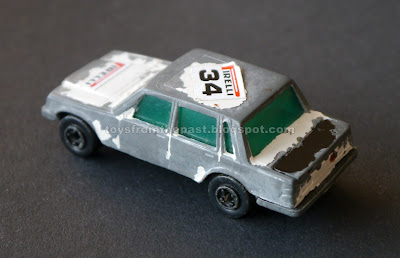I have seen pictures of this model in red or pink "Straz", green "Police" or white "Red Cross", but all of them with holes in the roof for a couple of sirens. This other toy that I have does not present the holes and comes with two stickers (one on the roof, another one in the bonnet) which are a racing number (RN34) and Pirelli logos, a bit in the style of rally cars. It is the only one of its kind that I have seen so far. The packaging (an important source of information) is unknown so far, so I cannot provide any remarks about Pinmark, the company that made them. The car is marked with number 001 in the base. Were there other models available? Was the numbering system (001 to, hypothetically, 999) a bit too ambitious?
The paintwork seems to be of very low quality, all cars I saw on the internet (except one) are playworn, and the interior is hidden by dark green windows. At the same time, the opening trunk is a sign of quality and the metallic base gives it some weight, which makes it looks like a more qualitative product in your hands. It is also noteworth that the base is painted black, when it would have been cheaper to leave it unpainted.
When it was new, I guess it looked great. We have to consider that, when it was made, Poland was still under a communist regime with limited access to foreign goods and raw materials, everything was done inland for the national market, which was closed to every other foreign toymaker, except maybe those of other socialist regimes.
FACTS AND FIGURES:
- Name: VOLVO 760 (Nr. 001)
- Scale: 1:64
- Year: Around 1985
- Company: Pinmark (Poland)
- Size: approx. 7 cm

.jpg)
.jpg)
.jpg)
.jpg)
.jpg)



.jpg)
.jpg)

.JPG)
.JPG)
.JPG)
.JPG)
.JPG)
.JPG)
.JPG)
.JPG)
.JPG)
.JPG)
.JPG)
.JPG)
.JPG)
.JPG)
.jpg)
.jpg)
.jpg)
.JPG)
.JPG)
.JPG)
.JPG)
.JPG)
.jpg)
.JPG)
.JPG)
.JPG)
.JPG)
.jpg)
.JPG)
.JPG)
.JPG)
.JPG)
.jpg)
.jpg)
.jpg)
.jpg)
.jpg)
.jpg)
.jpg)





.jpg)
.jpg)
.jpg)
.jpg)
.jpg)
.jpg)